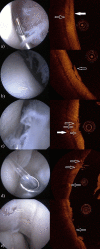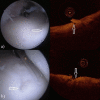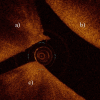Application of optical coherence tomography enhances reproducibility of arthroscopic evaluation of equine joints
- PMID: 24410869
- PMCID: PMC3901375
- DOI: 10.1186/1751-0147-56-3
Application of optical coherence tomography enhances reproducibility of arthroscopic evaluation of equine joints
Abstract
Background: Arthroscopy is widely used in various equine joints for diagnostic and surgical purposes. However, accuracy of defining the extent of cartilage lesions and reproducibility in grading of lesions are not optimal. Therefore, there is a need for new, more quantitative arthroscopic methods. Arthroscopic optical coherence tomography (OCT) imaging is a promising tool introduced for quantitative detection of cartilage degeneration and scoring of the severity of chondral lesions. The aim of this study was to evaluate the inter-investigator agreement and inter-method agreement in grading cartilage lesions by means of conventional arthroscopy and with OCT technique. For this aim, 41 cartilage lesions based on findings in conventional and OCT arthroscopy in 14 equine joints were imaged, blind coded and independently ICRS (International Cartilage Repair Society) scored by three surgeons and one PhD-student.
Results: The intra- and inter-investigator percentages of agreement by means of OCT (68.9% and 43.9%, respectively) were higher than those based on conventional arthroscopic imaging (56.7% and 31.7%, respectively). The intra-investigator Kappa coefficients were 0.709 and 0.565 for OCT and arthroscopy, respectively. Inter-investigator Kappa coefficients were 0.538 and 0.408 for OCT and arthroscopy, respectively.
Conclusions: OCT can enhance reproducibility of arthroscopic evaluation of equine joints.
Figures




References
-
- Neundorf RH, Lowerison MB, Cruz AM, Thomason JJ, McEven BJ, Hurtig MB. Determination of the prevalence and severity of metacarpophalangeal joint osteoarthritis in Thoroughbred racehorses via quantitative macroscopic evaluation. Am J Vet Res. 2010;56:1284–1293. doi: 10.2460/ajvr.71.11.1284. - DOI - PubMed
-
- Brittberg M, Winalski CS. Evaluation of cartilage injuries and repair. J Bon Joint Surg. 2003;56(Suppl 2):58–69. - PubMed
-
- Verwilghen DR, Enzerink E, Martens A, Franck T, Balligand M, Henrotin Y, Detilleux J, Serteyn D. Relationship between arthroscopic joint evaluation and the levels of Coll2-1, Coll2-1NO2, and myeloperoxidase in the blood and synovial fluid of horses affected with osteochondrosis of the tarsocrural joint. Osteoarthr Cartil. 2011;56:1323–1329. doi: 10.1016/j.joca.2011.08.002. - DOI - PubMed
Publication types
MeSH terms
LinkOut - more resources
Full Text Sources
Other Literature Sources
Medical

